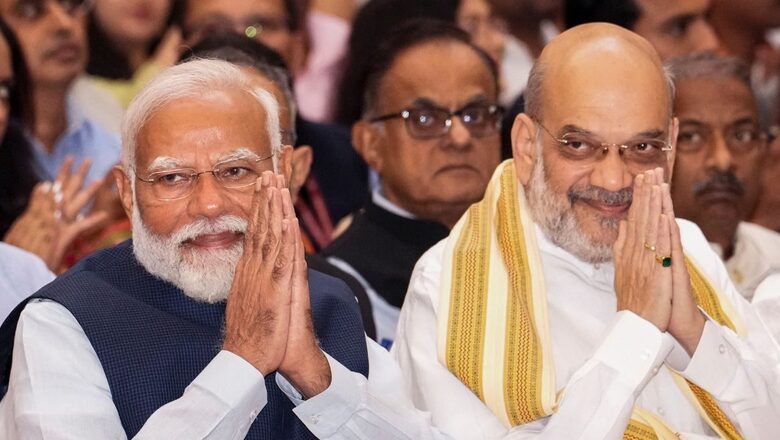
views
Thanks to Prime Minister Modi’s dynamic leadership, Manipur has seen significant progress. Under the PM Kisan Samman Nidhi Yojana, seven lakh farmer families are receiving hundreds of crores of rupees. Six lakh families benefit from the PM Garib Kalyan Yojana (PMGKY), while 80,000 houses have been built under the PM Awas Yojana (PMAY). The Ayushman Bharat Yojana (PMJAY) has provided free medical treatment to 4.25 lakh patients. Additionally, over 1.5 lakh families received free gas connections and over 1.3 lakh received free electricity connections. Furthermore, 30,000 toilets have been built, and the construction of oxygen plants, which were built in virtually every district during the Covid pandemic, are a testament to how relevant Manipur has been to the Modi government in the larger scheme of things.
Rahul Gandhi’s visit to Manipur last week, on the other hand, was only about wanting to get some brownie points. Don’t forget that the Congress never mainstreamed Manipur, which continued to suffer from “tyranny of distance” under decades of Congress misrule. Modi changed that.
The Northeast, particularly Manipur, has been the subject of heated debate in recent months. As is typical of the Opposition, it has embarked on a diabolical game of politicising the events in Manipur for narrow political gains. The Modi government has always stood for accountability and good governance. According to keen political observers, what transpired in Manipur last year is a dangerous mix of various factors: rampant poppy cultivation and drug abuse in many areas by notorious narco traders, the hills versus plains controversy, ethno-religious conflict, border tensions arising from the influx of illegal migrants from Myanmar, and all these spiralling into violent lawlessness after the Manipur High Court judgement in April 2023 that said the state government should consider inclusion of Meiteis under the Scheduled Tribe (ST) category.
The Manipur police had registered a case against unidentified armed persons under sections of abduction, gang rape and murder at Nongpol Sekmai police station in Thoubal district on May 18, 2023. The CBI, last year, took over the FIR registered by the Manipur police as per the agency’s procedure. The CBI then deployed a special investigation team (SIT) in Manipur under a DIG-rank officer. Multiple arrests have been made with respect to the horrific incident of the gangrape of two Kuki women, with every BJP leader demanding nothing less than capital punishment for the culprits. Buffer zones have been created to prevent escalation of conflicts and a significant amount of illicit grenades, rifles, live cartridges and ammunition have reportedly been seized from militant groups. Over 50,000 people from Manipur have been rehabilitated and evacuated to safety by the Modi government.
Last year, the Central government asked the Supreme Court to transfer the Manipur violence case trial outside of the state, aiming to ensure a free and fair trial. The Centre also requested the apex court expedite the trial for all cases related to the Manipur violence, including the gang rape case. Furthermore, under the Ministry of Home Affairs directive, the campaign to collect biometric data from illegal Myanmar immigrants in Manipur has resumed with increased intensity.
Look at the stark contrast: while the Modi government voluntarily handed over the Manipur case to the CBI, you have a thoroughly insensitive TMC government under an equally insensitive and rudderless Mamata Banerjee, who spent taxpayer funds to petition the Kolkata High Court repeatedly, opposing a CBI probe into the gory 2023 Sandeshkhali gangrape cases involving senior TMC leader Shahjahan Sheikh. Law and order has collapsed in West Bengal under Mamata. Similarly, a few months ago, in a classic case of love jihad, Neha Hiremath was murdered in cold blood by a radical Islamist in Congress-ruled Karnataka. Rahul Gandhi hasn’t had time to visit Neha’s family, but he is quick to visit Manipur, purely driven by political opportunism.
Now the moot question is, has the BJP done enough for Manipur? Yes, the BJP and the Modi government have been working tirelessly, engaging in multiple rounds of talks between the warring Kuki and Meitei factions. Union Home Minister Amit Shah has held several all-party meetings on the Manipur issue in recent months and has maintained constant contact with various stakeholders to achieve a peaceful resolution. He has frequently visited Manipur and stationed himself there for extended periods. In sharp contrast, during similar violence in the mid-1990s under the erstwhile Congress regime, the Congress didn’t even consider it necessary to send their Home Minister. They simply sent their MoS Home, Rajesh Pilot, to defuse the situation. Pilot spent a mere 3 hours in Manipur before hastily returning to Delhi – a brazen display of insensitivity and callousness.
That Prime Minister Narendra Modi has visited the Northeast over 50 times—and his Cabinet ministers over 400 times in the last ten years— is a testimony to the fact that PM Modi never allowed the “tyranny of distance” to prevent his government from working for the welfare of the Northeast. In stark contrast, former PM Manmohan Singh of the Congress was a Rajya Sabha MP from 1991 till 2019 from Assam for 28 long years, but he did not visit the region even three times during this period. Congress MP Gaurav Gogoi, who moved the no-confidence motion against the Modi government last year, is the son of Tarun Gogoi. Despite serving as Chief Minister of Assam for 15 years (the longest tenure), Tarun Gogoi did precious little for the people of Assam.
In fact, it was the Modi government that brought broad gauge rail to large parts of Assam and Tripura in 2016 and Sikkim’s first full-fledged airport in 2018. Contrast this with the Congress’s handling of the Bogibeel Bridge. Started in 2002, work on this vital bridge over the Brahmaputra River in Assam was abandoned when the Congress came to power at the Centre in 2004. The Modi government ultimately completed this combined road-and-rail bridge—India’s longest and Asia’s second longest—which can withstand earthquakes up to magnitude 7 and boasts a lifespan of approximately 120 years.
The Dhola Sadiya Bridge tells a similar story. Construction began in 2011, only to be abandoned midway by the Congress. Yet again, it was the Modi government that completed the project in 2017, delivering this vital beam bridge that serves as the first permanent road link between northern Assam and eastern Arunachal Pradesh. Clearly, mainstreaming the Northeast through infrastructural connectivity has been a signature achievement of PM Modi’s tenure. The limited point is this—successive Congress governments at the Centre did absolutely nothing to mainstream the Northeast with the rest of India, for decades altogether. This arduous task has been deftly consummated by PM Modi and his team.
It’s no surprise then that the BJP romped home to victory for the second time in a row in the 2021 Assam Assembly elections. In the Tripura Assembly elections in 2023, while the Congress was reduced to just 3 seats, the BJP won consecutively for the second time in a row, with a solid 32 seats. Since Manipur became a state on 21 January 1972, the last seven years under the double-engine BJP government have been the most peaceful in Manipur’s 52-year-old history, barring the last few months. But to focus solely on these past few months while disregarding the commendable work of the BJP government in Manipur over the last seven years exposes the Opposition’s rabid hypocrisy.
More than anything else and beyond electoral politics, the events of the last few months in Manipur are largely a simmering legacy issue and the result of the Congress party’s abject lethargy when it ruled the Northeast for the longest time. For instance, the Assam Accord of 1985 was signed when Rahul Gandhi’s father, Rajiv Gandhi, was the PM, but nothing was done to empower indigenous Assamese people. That work was done by the Modi government. Similarly, the 1986 Mizo Accord, also signed during Rajiv Gandhi’s tenure, saw its promises fulfilled only by the responsive Modi government, decades later. The 1988 Tripura Accord met the same fate – signed under Rajiv Gandhi but enacted under Modi. Even the Karbi-Anglong and Bodo Accords, signed during Prime Minister PV Narasimha Rao’s term, saw elections for their respective councils only in 2020-21, thanks to the commitment of the Modi government.
How many times did Rahul Gandhi visit Manipur, Arunachal Pradesh, Assam, Mizoram, Meghalaya, Nagaland or Tripura since 2004, when he became a Member of Parliament? Barely. Don’t forget, Rahul’s Bharat Jodo Yatra ended on January 30, 2023. Assembly elections in Tripura were held on February 16, 2023, but he did not visit Tripura even once. Again, Assembly elections were held in Meghalaya and Nagaland on February 27, 2023, and yet again, Rahul Gandhi did not visit Nagaland even once. As for Meghalaya, he had a whistle-stop tour for a few hours in Shillong. That shows the lack of commitment on the part of the Congress party which has now suddenly woken up from deep slumber and has been whipping up passions, just when things are returning to normalcy in Manipur. Again, don’t forget, in 2010-11, under the Congress rule both at the Centre and in Manipur, there were times when crippling curfews lasted for anywhere between 124 to 139 days at a stretch. How many times did Rahul Gandhi visit Manipur in 2010-11? Not even once.
In a historic first, S. Phangnon Konyak became the first Naga woman to be appointed to the Rajya Sabha in 2023. She also holds the distinctions of being the first-ever female Vice-Chairperson from the Northeast in the Rajya Sabha and the first woman from the region to preside over its proceedings. That it took 76 years in post-independent India for a Naga woman to become a member of the distinguished House of Elders is a tad surprising. However, that it happened under the aegis of Prime Minister Narendra Modi is hardly surprising. His commitment to women-led development and outreach to the Northeast is unparalleled.
Violence erupted in Manipur on May 3, 2023, sparked by a “tribal solidarity march” organised by the Kuki community in the hill districts. The march aimed to protest the majority Meitei community’s demand for Scheduled Tribe (ST) status. This demand had been gaining momentum, with Meitei groups arguing that successive governments had ignored their pleas for inclusion in the ST list for over a decade. The situation escalated when, acting on a petition by the Meetei (Meitei) Tribe Union, the Manipur High Court directed the state government to expedite the Meitei community’s request for ST status and send a recommendation to the Union government within four weeks. Experts view this as the tipping point that ignited the violence.
Thousands participated in the solidarity march called by the All Tribal Students Union of Manipur (ATSUM) across all ten hill districts, to oppose the demand for inclusion of the Meitei community in the ST category, say observers. The ATSUM said the march had been organised to express dissent to the “persistent demands of the Meitei community for its inclusion in the ST category” gaining momentum. While the lawmakers of the valley areas are openly endorsing the Meitei demand, those in the hills are opposed to the same.
It is pertinent to note here that the Meiteis inhabit the Manipur valley, which constitutes barely 10 per cent of the geographical area of the state. Meiteis claim that they are facing difficulty in view of the large-scale illegal immigration by Myanmarese and Bangladeshis. Compounding the problem additionally for the Meiteis is the fact that they are not allowed to settle in the hill areas as per the existing law. Kukis on the other hand, have benefitted due to colonial-era laws dating back to 1907. The Scheduled Tribe Demand Committee of Manipur (STDCM), which has been spearheading the movement for the inclusion of the Meiteis in the ST category for more than a decade, has repeatedly said the demand is being made not merely for reservation in jobs, educational institutions and tax relief. It is more about protecting the ancestral lands, culture and identity of the Meitei people, who are threatened constantly by illegal immigrants from Myanmar, Bangladesh and by the Kukis.
The Meitei community, largely Hindus, account for 60 per cent of the total population in Manipur but occupy only 10 per cent of the land. On the other hand, Kukis and other tribes who are largely Christians by faith, account for only 40 per cent of the population, but occupy and inhabit 90 per cent of the territory. Clearly, as per political observers, it is the systematic marginalisation of the Meitei Hindus over decades together, which finally led to the events as they unfolded post-May 3, 2023. While violence against women has to be condemned and there can be no excuses whatsoever for condoning it, equally, the question that begets a response is – why did the Congress, which ruled India for the longest time at the Centre, never bother to give the Meiteis their rightful dues or accord them their rightful place in Manipur?
Even as over 4600 schools have reopened in Manipur and normalcy is returning, the Opposition led by the likes of the Congress and the TMC, has been attempting to weaponise the narrative around Manipur, with irresponsible politics via futile visits. If TMC leaders can travel from Kolkata to Manipur, which is 1490 km away, why couldn’t they travel from Kolkata to Howrah, which is just 19 km away, and from Kolkata to Malda, which is just 329 km away? The reason is simple. In Howrah & Malda, it was the BJP’s women karyakartas who were paraded naked by TMC goons in full public glare. So the TMC or the Congress simply do not care. The Opposition is scavenging on the wounds of the people in Manipur, when the Modi government is doing all it can, and all it should, to heal them.
The fact that all eight Northeast states have been voting in large numbers in the last ten years for PM Modi’s inclusive model of governance speaks volumes of how the Modi model has truly ensured last-mile delivery in the Northeast, to those who were barred from even the basic amenities of life under successively repressive regimes of both the Congress and the Left. Kukis in Manipur have always wanted a semi-autonomous region, while Meiteis have only wanted ST status. Many Nagas of Manipur want to be part of “larger Nagaland” or Nagalim, as they call it, according to political experts. The Modi government is working tirelessly to reconcile the diverse interests of these warring groups.
The Suspension of Operation (SoO) agreement was signed in 2008 under which, the then Congress government at the Centre was supposed to rehabilitate key Kuki insurgent groups, but as always, Manmohan Singh and his kitchen cabinet led by Sonia Gandhi snoozed on this subject, which widened the fissures between Kukis and Meiteis as time flew by. Today, under the aegis of the Modi government, AFSPA has either been or is being removed, from 15 police station areas in seven districts of Nagaland; 15 police station areas in six districts of Manipur; and 23 districts entirely and one district partially in Assam.
Specifically speaking about Manipur, the BJP won 32 seats in the Assembly elections in 2022 while the Congress was reduced to a measly 5 seats. That defeat must have deeply hurt the Congress, which is now using the Manipur issue to settle political scores. Even in the 2023 Assembly elections in Nagaland, which has over 93 per cent Christian and tribal population, the BJP and its ally, the NDPP, won 37 seats overall, while the Congress got zero. The electoral annihilation of the Congress in the Northeast is complete and that is precisely why it is using the Manipur issue to regain lost political capital, by stoking the embers of discord.
However, thanks to PM Modi’s relentless and resolute focus on the development of Manipur, the state is returning to normalcy to reclaim its rightful place as the soul of Northeast, with its emerald tea gardens, rolling hills, dense forests and captivating beauty.
Sanju Verma is an Economist, National Spokesperson for BJP and Bestselling Author of “The Modi Gambit”. Views expressed in the above piece are personal and solely those of the author. They do not necessarily reflect News18’s views.
















Comments
0 comment